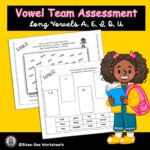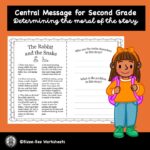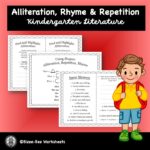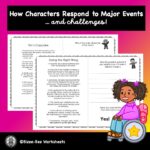If you’re anything like I was as a brand new teacher, the idea of literacy centers in the elementary classroom sounds a bit intimidating. Nevermind that you have 20+ little ones to manage, but on top of that, you’re expected to know how to run several literacy stations at once.
I hear ya. And while there are undoubtedly many of you mature teachers out there who likely know how to run your classroom centers like a pro, the truth is that hitting your stride as a new teacher can be hard. In this post, I’m breaking down the framework of literacy centers: what they are, how they work, and how you can make them work for both you and your students. And while I’m saving my best tips and tricks for literacy center engagement for another post, this can at least help you navigate the ins and outs to help you get off on the right foot.
So, without further ado, let’s dive into my 6 most effective tips for setting up literacy centers in the elementary classroom.

What are “literacy centers”?
According to Reading Rockets, literacy centers are designated areas within the classroom that contain independent or collaborative activities, designed to help a group of students achieve their reading goals. Reading centers can look different from classroom to classroom, and which literacy centers (also known as “reading stations,” “literacy stations,” and other names) you utilize is up to you based on the needs of your students.
The following are a few types of literacy centers (or stations) you may find in different classrooms:
- Fluency
- Listening
- Computer
- Book club
- Word work
- Poetry
- Independent reading
- Small group
Effective Tips for Setting Up Literacy Centers in the Elementary Classroom
The following are six tips that are imperative for setting up efficient and effective literacy centers for your primary school classroom. Please note that this is not an exhaustive list, but can serve as a great starting point, especially if you’ve never tried implementing reading centers in your classroom before.
Tip 1: Decide which skills to focus on
Before setting up your reading centers, you’ll first want to decide which skills you want to hone in on. It’s extremely important that you focus on a variety of reading and literacy skills in order to give students plenty of practice over a broad range of reading tasks and skills.
Some school districts will tell you what centers they want you to focus on, while others may allow you some flexibility. If you’re homeschooling, you’ll include whichever areas of focus are best for your kiddos. Whatever the case, deciding which stations you’ll offer your students is crucial, as this is your opportunity to give your students practice in specific reading concepts daily. – and you won’t want to skip the essential skills.
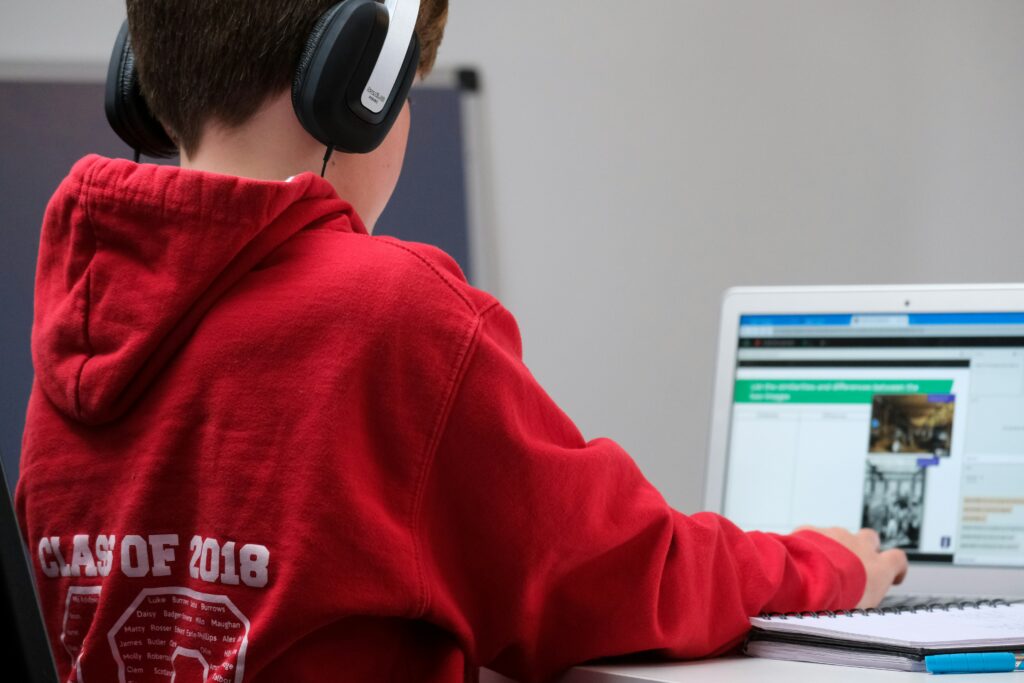
Tip 2: Use informed strategies to form each reading group
When it comes to forming literacy centers in the elementary classroom, strategy is everything. You’ll want to make sure that you form each group based on data of some sort –- for me, I used the diagnostics reports as set forth by district assessments. As a now homeschooling mom, Ive also used programs like IXL to assess my kiddos since I no longer have access to district-administered assessments.
Grouping students according to their skillsets serves several purposes. It allows you to tailor each literacy center to your student’s individual needs without necessarily having to prepare an individualized plan for each student. By grouping similarly performing students, you can target and strengthen weaker skills while strengthening others, introducing new concepts as you go along.
Of course, not all students will stay in their assigned reading groups the entire year – you’ll have some that “catch on” and soar far beyond where they started -– good for them! In that case you’ll move them out of their current group and into another that’s better suited for their needs.

When grouping students, strive to make the process as fun as you can. Allowing student groups to come up with and/or vote on their own group names can make them feel a part of the process. If you’re like me and would rather just get right to teaching (I feel ya!) then you can skip the voting and assign names yourself –- just don’t be boring. Come up with fun names and themes (I’ve used everything from nature-themed groups (river, mountain, lake, etc.) to animal groups (cheetahs, cobras, and so on) –- consider what interests your students and go from there).
Please note that when assigning names to a group, you should NEVER pick names in accordance with student performance. For example, don’t name a low-performing group the “red” group and a high-performing group the “green” group. While it makes sense, it may also carry with it an unspoken condemnation and approval Instead, keep things fun and indiscernible; the kids will love it.
Tip 3: Set realistic expectations about how long your literacy centers will take
How long literacy centers will take will depend on several factors, but generally speaking, they’ll usually last about 1-2 hours. Depending on your schedule, you can carry out your literacy centers over the course of the day (such as completing a few rotations in the morning and a few after lunch) or knock ’em out all at once.
Either way, I’d suggest allotting at least 10 minutes to each center, with at least 2-3 minutes of transition time spent organizing each station before moving to the next. If you have five stations, this means literacy centers will last for one hour or more. Of course, the more stations you have, the longer your literacy centers will take; be sure to plan accordingly.
Tip 4: Don’t forget to foster smooth transitions
Transitioning between centers can be chaotic, so make sure you’ve allowed the kiddos plenty of time to practice before expecting a flawless routine. In my classroom, I had a buzzer set a few minutes before I knew I wanted students to switch to the next center. I’d set the timer, and when it rang, the student would stop what they were doing, raise both hands in the air, and look at me. Raising both hands in the air (with a quiet mouth) one unique and effective way for children to show they are listening.
Once student were quiet I’d release them to begin cleaning before walking (and I do mean walking …) to the next center. There are many ways this can be done, so don’t feel like my technique is the end all be all. Basically, you want to form a well-thought-out routine, have students practice it, and then enforce your expectations along the way.

Tip 5: Don’t be afraid to switch things up
As I said before, the types of centers you choose to use as part of your literacy centers will totally depend on the skills you (or your district) wish to target. This means that if a station like “word work” needs to be swapped out for a different set of skills you need to hone in on, go for it. There aren’t any hard and fast rules here as long as your students are getting what they need.
With that said, you’ll always want to make informed decisions about who belongs in each group as you’ll be coming up with each one according to skillset. As such, you’ll need to monitor the progress of your students often and be flexible enough to rotate students in and out of groups based on their growth.
This means that if a child scores midrange on their initial diagnostic assessment but skyrockets their score upon the next assessment, it makes sense to switch that student to a higher performing group to ensure that he or she is getting the enrichment he or she needs. Thus, being flexible is crucial for ensuring all children receive the instruction required to be successful.
Tip 6: Practice makes perfect
If you hear nothing else, hear this: your students will need to practice literacy centers in the elementary classroom before it starts to flow well. That means your students will need to practice “doing” literacy centers without actually doing them.
Will it be chaotic? Yes. Will it your students get better with practice? Definitely. Practice is the only way they’ll be able to know how to implement the expectations you’ve set.
So, how might these practice sessions look? Introduce the entire class to each reading center at a time. Talk to the entire group about what transitions will look like (I recommend using a digital timer like the one on Class Dojo) and what cleanup expectations are. Inform students of what being “on task” will look like, as well as what they can expect to happen if expectations aren’t met.
Then, split your students into groups and let them practice each center – you can give them a small task at each station (this part doesn’t need to be differentiated since its only a practice routine) spending maybe a minute or two at each before switching stations, transitions and all.
The Specific Literacy Centers I Used in My Classroom
The following are the literacy centers I used in my second-grade classroom, as set forth by my school district.
“Teacher Table”/Small Group
The “Teacher Table” ended up being my favorite part of literacy centers for the elementary school classroom, albeit intimidating at first. The teacher table works in tandem with the small group review station (introduced next) and is the time you meet with individual student groups.
Ideally, you’ll call each student group back to your “table” (or whatever setup you have) for one-on-one instruction tailored to their needs. Every group you’ve created for literacy centers should have a place at the teacher’s table – not only those who perform below grade level. Your gifted students, “bubble kids“, and more should all have daily activities geared towards boosting their performance.
Before you call your students back to the teacher table be sure to know what you want to achieve. Do your kiddos need help with comprehension? Break out the comprehension worksheets. Do they need a boost in above-level vocabulary? Try out vocabulary bingo! All of this and more boosts learning and can even foster a deeper bond between yourself and your students as you give them the one-on-one support they crave in a small group environment.

Small Group Review
Small group review works in tandem with the Teacher Table. It functions as a designated area where students complete tasks that further reinforce concepts taught during small group instruction. While this center is totally optional, I highly recommend it. It’s nice to be able to assess what students took away from the small group lesson. Just be sure to keep age and skill level in mind — not everything you do with a student one-on-one can be carried out by students independently, so be sure to use your best judgment.
Fluency
According to the National Center for Improving Literacy, fluency is “the ability to read words, phrases, sentences, and stories accurately, with enough speed, and expression.” Becoming a fluent reader isn’t just about sounding good, though –- it’s also about comprehending what is being read.
So, how do you pull it off? I like to use passages that are fun, interesting, and “on level.” This makes reading fluency passages less of a chore for the student. Some fluency passages come with numbers at the end of each line, which help keep track of how many words your student read. Many teachers have students read a passage three times, with the hope that the student will read faster and more accurately with each try. I offer fluency worksheets in my online TPT store that come numbered and can double as engaging poetry for kindergarteners, first grade, and second graders, if you’re looking for fun options that won’t break the bank.
“Word Work”
“Word work” is an arbitrary term but basically refers to the breaking apart of, manipulating, or working with words. This one was always a nifty center for me, since there was such a broad scope of readers in my second grade classroom. As such, exploring concepts like vowel teams, context clues, and more are great ideas for the word work station that can help your students learn more about words and how to manipulate them, making them that much better of a reader and writer.
Independent Reading
What would literacy centers in the elementary classroom be without a good dose of independent book reading, right?
Of course,you’ll want to engage your little readers with books that specifically target their reading level, so be sure you have reading materials on hand that your students feel confident reading on their own. In our district we always used Raz-Kids for this purpose – it “leveled” our kiddos for us by gauging their reading level and then gave them digital books they read (via iPad) in accordance with their reading skills.
Whether you’re using digital or traditional books, the concept of giving your students the opportunity to read on their own is paramount, especially when you set up a conducive, relaxing, and engaging reading environment.

Computer Time
“Computer time” is when students will log onto the computer (or laptop) for guided digital instruction. If your district doesn’t have a common online learning program, you could just as easily find your own. These can be particularly helpful as they often assess the student as they go and adjust according to your student’s needs and ability. Computer time also helps your students hone in on their technology skills while also giving them something to look forward to –- assuming they like the online material provided that is!
Setting Up Literacy Centers in the Elementary Classroom Can Be Easy!
All in all, how you set up your literacy centers in your classroom will largely on the skills you wish to target. Though literacy centers will look differentkly from one classroo. to the next , what’s most important is that you know how you want your centers to flow, have your students practice centers before doing them, and that the content within each reading center is engaging, practical, and efficient.
Stay tuned for all of my best strategies for keeping students on task during literacy centers — but until then, teach on!


